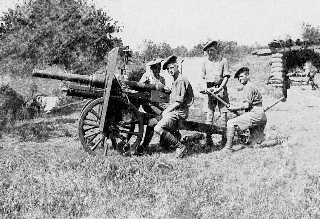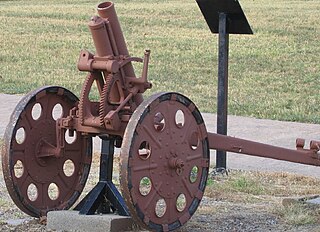 W
WThe 7 cm Gebirgsgeschütz M 75 was a mountain gun used by Austria-Hungary during World War I. Despite its 7 cm designation it actually fired a 66 mm (2.6 in) projectile. The Austro-Hungarian Army rounded up to the nearest centimeter for their designations. It was obsolete upon introduction as it had a bronze barrel and no recoil mechanism so it had to be relaid after every shot. The gun had an early form of Krupp horizontal sliding-block breech and it fired separate-loading, bagged charges and projectiles. Due to its low profile, its breech could recoil into the ground so its angle of elevation was restricted which was a significant handicap for a mountain gun which needed high angles of elevation. For transport, the Gebirgsgeschütz M 75 could be broken down into two loads.
 W
WThe 7 cm Gebirgsgeschütz M 99 was a mountain gun used by Austria-Hungary during World War I. It was obsolete upon introduction as it had a bronze barrel, a spring-loaded spade to absorb the recoil forces and it had to be relaid after every shot. The high elevations required of mountain guns greatly complicated the provision of barrel recoil systems as the breech could recoil into the ground, and it would be some years before satisfactory systems were developed. These would result in the 7 cm Gebirgsgeschütz M 8 and M 9 that used the same barrel and ammunition as the M 99, but had Gun shields and more advanced recoil systems. These guns weighed 402 kilograms (886 lb) and 456 kilograms (1,005 lb) respectively, although the exact differences between them are unclear other than they broke down into four and five loads for transport respectively.
 W
WThe Ordnance BL 2.75-inch mountain gun was a screw gun designed for and used by the Indian Mountain Artillery into World War I.
 W
WThe Ordnance BL 10 pounder mountain gun was developed as a BL successor to the RML 2.5 inch screw gun which was outclassed in the Second Boer War.
 W
WThe Škoda 7 cm guns were a family of naval guns and dual-purpose guns of the Austro-Hungarian Empire that were developed and produced for the Austro-Hungarian Navy in the years before and during World War I. These guns were actually 66 mm, but the classification system for artillery rounded up to the next highest centimeter. Following the defeat of the Central Powers in World War I and the dissolution of the Austro-Hungarian empire the ships of the Austro-Hungarian Navy were divided among the victorious allies and some guns continued to be used until World War II.
 W
WThe Škoda 7 cm K10 was a dual-purpose gun of the Austro-Hungarian Empire that was used by the Austro-Hungarian Navy during World War I. The gun was actually 66 mm, but the classification system for artillery rounded up to the next highest centimeter. The 7 cm K10 was also used by the Italian Navy on ships ceded as war reparations and as coastal artillery during World War II. The Italians referred to it as the 66/47.
 W
WThe Type 11 70 mm infantry mortar, was a muzzle-loading, rifled bore infantry mortar used by the Japanese. The Type 11 designation was given to this gun as it was accepted in the 11th year of Emperor Taishō's reign (1922). It was first used in 1922 and was the first mortar to be introduced by the Imperial Japanese Army. The mortar was later replaced by the Type 92 battalion gun.
 W
WThe Type 92 battalion gun was a light howitzer used by the Imperial Japanese Army during the Second Sino-Japanese War and World War II. The Type 92 designation was for the year the gun was accepted, 2592 in the Japanese imperial year calendar, or 1932 in the Gregorian calendar. Each infantry battalion included two Type 92 guns; therefore, the Type 92 was referred to as "battalion artillery" .